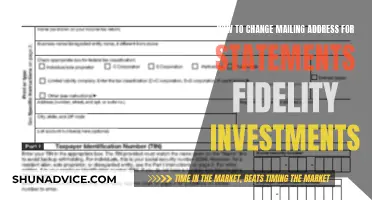
Investing in a bond index fund is a good option for those who want to diversify their portfolio and generate income. Bonds are a way for governments or companies to borrow money from investors in exchange for regular income. Bond index funds are mutual funds that pool capital from investors and allocate it to various fixed-income securities. They are a good option for those seeking exposure to different types of bonds, such as government, municipal, and corporate bonds. While they offer diversified exposure, they also come with the risk of losing value due to changes in interest rates, credit risk, and market sentiment. It is important to do your research and consult a financial advisor before making any investment decisions.
| Characteristics | Values |
|---|---|
| Purpose | To borrow money from investors |
| Income | Paid out on a regular basis |
| Risk | Interest rate risk, credit risk, liquidity risk, inflation risk |
| Diversification | Can help diversify equity portfolios |
| Investment | Can be purchased through auction or via a broker |
What You'll Learn

Bonds vs. bond funds
Bonds and bond funds are both debt instruments that can play an important role in a diversified investment portfolio. Bonds are loans made to governments or companies, which offer regular income in the form of coupon payments. Bond funds, on the other hand, are investment funds that pool money from multiple investors to purchase a diverse range of bonds.
Benefits of Individual Bonds:
- Control and Transparency: Investors have greater control over their portfolio and can easily align their investments with their goals, risk appetite, and desired returns.
- Predictability: Bonds offer a predictable income stream with defined returns and maturity dates.
- No Additional Management Fees: There are no ongoing management fees associated with individual bonds.
Drawbacks of Individual Bonds:
- Lower Frequency of Income: Bonds typically provide returns semi-annually, requiring active management for stable income.
- High Cost: Bonds are generally priced higher and may be cost-prohibitive for some investors.
- Diversification Challenge: Achieving a diversified bond portfolio requires investing in multiple bonds, which can be expensive.
- Less Attractive Pricing: Institutional investors often receive better pricing than individual investors.
- Research and Management Intensive: The bond market is complex and diverse, requiring significant research and management time.
Benefits of Bond Funds:
- Consistent Income: Bond funds provide a consistent income stream or reinvestment opportunities.
- Cost-Effective and Accessible: Bond funds have lower minimum investment requirements, making them more accessible and cost-effective for building a diversified portfolio.
- Liquidity: Bond mutual funds offer daily liquidity, and bond ETFs offer intraday liquidity.
- Diversification at a Lower Cost: Bond funds pool a variety of bonds, offering greater diversification per dollar invested.
- Less Intensive Research: Comparing and researching bond funds is generally less time-consuming than individual bonds.
- Institutional Pricing: Bond funds may benefit from institutional pricing, reducing costs.
Drawbacks of Bond Funds:
- Less Control and Transparency: Investors have less control over specific bond holdings and must rely on fund managers' decisions.
- Management Fees: Bond funds incur management fees, which can impact overall returns.
- NAV Market Fluctuations: Bond funds' net asset value (NAV) is influenced by prevailing market interest rates, leading to more volatile performance.
- Tax Consequences: Capital gains distributions in bond funds can be challenging to anticipate and plan for from a tax standpoint.
Key Takeaways:
The choice between individual bonds and bond funds depends on various factors, including the amount of capital to allocate, financial goals, and the level of research and management effort desired. Individual bonds offer greater control and predictability but require more time, expertise, and financial resources. Bond funds provide liquidity, diversification, and accessibility, making them a popular choice for investors seeking a simpler approach to bond investing.
Artemis Vega Fund: A Smart Investment Strategy
You may want to see also

Bond funds vs. bond ETFs
Bond funds and bond ETFs are two investment options that pool funds into a diversified, fixed-income portfolio. However, there are some key differences between the two.
Bond Funds
Investing in a bond fund means you are putting your money into a mutual fund, where a professional invests that pool of money. In an actively managed fund, the manager invests according to what they think are the best opportunities, in line with the fund's goals. In an indexed fund, the manager tracks the performance of an underlying bond index.
Bond funds offer more control over what you invest in, such as US or global debt, investment-grade or lower-rated debt, and taxable or municipal debt. However, once you're invested, you don't have control over the specifics of what the fund holds. They also require less research and oversight, as you don't need to research individual bonds or issuers.
Bond funds typically charge expense ratios to cover management and research costs, and there may be additional transaction or sales fees. The frequency of income is generally monthly, and there is usually a minimum investment requirement, although this varies between funds.
Bond ETFs
Bond ETFs (exchange-traded funds) also pool investors' money and buy bonds that fit a defined mandate. They are traded on exchanges throughout the trading day, offering real-time pricing and the ability to respond swiftly to market changes.
ETFs typically have lower fees than bond funds, making them more cost-efficient. They also offer greater transparency, as they disclose their holdings daily. There is usually no minimum investment requirement, and you can buy a single share.
However, as ETFs trade throughout the day, the market price can fluctuate. They are also less tax-efficient due to frequent buying and selling, which can lead to capital gains distributions.
The decision between bond funds and bond ETFs depends on your investment goals, risk tolerance, and financial strategy.
If you want active management and more choices, bond funds offer a wider range of options. If you plan to buy and sell frequently, the flexibility of ETFs may be a better choice. For long-term investors, both options can meet your needs, but it's important to research the specifics of each fund.
If transparency is important, ETFs allow you to see the holdings of the fund at any time. However, if you're concerned about not being able to sell due to a lack of buyers, bond funds might be preferable as you can sell your holdings back to the fund issuer.
Fidelity Funds: Exploring AMD Investment Opportunities
You may want to see also

Pros and cons of investing in bonds
Pros of Investing in Bonds:
- Bonds are a way to lend money to a company or government in exchange for income, which is paid out at regular intervals.
- Bonds can be used to supplement your income, as the regular payments can help generate income.
- Bonds can help offset the effects of inflation, which could potentially erode the value of your money.
- Bonds can help diversify equity portfolios, potentially lowering the risk of all investments falling at the same time.
- Bonds are typically less risky than stocks or equity funds.
- Bonds can offer relatively high returns compared to other low-risk investment options, such as savings accounts or certificates of deposit (CDs).
- Municipal bonds from local, city, or state governments are often exempt from federal income taxes, and may also be exempt from state and local income taxes.
- Federal bonds are sometimes considered risk-free investments, as the government has the power to print money.
- Corporate bonds can be safer than buying a company's stock, as bondholders will often get some of their investment back if the company files for bankruptcy.
Cons of Investing in Bonds:
- The value of bonds will typically drop if interest rates rise, which could impact your returns if you sell before maturity.
- Yields might not keep up with inflation, decreasing the value of the fixed income received from the bond over time.
- Some bonds can be called early, meaning the issuer repays the bond early, cutting off your income stream.
- Corporate bonds can be riskier than government bonds, as there is a chance of the company defaulting on its debts.
- Local or state bonds might be slightly riskier than federal bonds, although defaults are rare.
- The income from federal bonds is often exempt from local and state income taxes but is still taxed at the federal level.
- The interest on some bonds, such as I bonds, is subject to federal income tax, which depends on your income.
Bond Funds vs Individual Bonds: Pros and Cons for Investors
You may want to see also

Types of bond issuers
There are several types of bond issuers, including corporations, governments, supranational entities, regions and municipalities, and special projects and SPVs.
- Corporations: One of the largest categories of bond issuers, corporations include financial institutions, public sector undertakings, and private companies. They issue bonds to raise money for various reasons, such as funding day-to-day operations or expanding their businesses. Examples include well-known companies like Microsoft, Apple, and Facebook.
- Governments: Government bonds are the second most common type, with the US Treasury Bond being a prominent example. The credit rating of these bonds depends on the specific government issuing them. Bonds issued by developed countries like the US are considered less risky and are generally rated higher than those issued by developing countries.
- Supranational Entities: These are global entities not based in a specific nation, such as the World Bank and the International Monetary Fund (IMF). They are highly rated and considered less risky due to their international standing.
- Regions and Municipalities: Smaller municipalities issue bonds similar to governments, and these are usually rated similarly to the national government. While not issued directly by the national government, they are typically backed by its full faith.
- Special Projects and SPVs: Firms or governments may issue bonds for specific projects, such as infrastructure development. The proceeds from these bonds are used to finance the project, and coupon payments and principal amounts are paid from the project's revenue.
Bond issuers play a crucial role in capital markets by borrowing from investors to fund their operations or projects. In return, they make periodic interest payments and repay the principal amount upon the maturity of the bonds.
Ethical Investment Funds: Choosing the Right Option
You may want to see also

How to choose a bond index fund
When choosing a bond index fund, it is essential to consider several factors to ensure that the investment aligns with your financial goals, risk tolerance, and investment horizon. Here are some guidelines to help you make an informed decision:
- Investment Goals and Strategy: Different bond funds have different investment goals, such as income generation or capital preservation. Understand the strategy the fund follows to achieve those goals. Some funds invest only in government or agency bonds, while others focus on corporate, municipal, or foreign bonds. Some funds also offer a combination of these bond types. Ensure the fund's approach matches your investment objectives.
- Investment Horizon: Consider how long you intend to keep your money invested. If you have a short-term horizon (less than a year), money market funds or ultra-short-term, high-quality bond funds might be more suitable. For longer investment horizons, you can explore short-term, intermediate-term, or long-term bond funds, depending on your risk appetite and potential for higher returns.
- Income vs. Long-Term Growth: If you're investing for current income, conservative bond funds, such as investment-grade short-term bond funds, can provide more stable returns with lower risk. On the other hand, if you're investing for long-term growth, more aggressive bond funds, like long-term or multi-sector bond funds with high-yield components, may be appropriate.
- Risk Tolerance: Assess your comfort level with risk. If you have a low-risk tolerance, money market funds or high-quality, short-term bond funds might be preferable. For those willing to take on more risk for potentially higher returns, intermediate-term bond funds or those with exposure to higher-yielding, lower-quality bonds can be considered.
- Credit Quality and Ratings: Evaluate the credit quality of the bond fund by considering the credit ratings of the underlying securities. Funds that invest in lower-quality, speculative, or high-yield bonds can offer higher yields but come with greater volatility and a higher risk of default. Independent rating agencies like Standard & Poor's, Moody's, and Fitch provide letter-based credit ratings, with AAA being the highest.
- Performance and Returns: Look beyond short-term performance and consider the fund's total return over a more extended period. Assess the fund's income-generating potential by reviewing its 30-day yield, but remember that higher yields may be associated with higher credit risk and potential volatility.
- Fees and Expenses: Understand all the fees and expenses associated with the bond fund, as they will impact your overall returns. These may include expense ratios, sales charges, redemption fees, and annual account fees. Compare these costs across different funds to make an informed decision.
- Fund Management: Choose funds managed by reputable companies with a strong commitment to research and analysis. Review the qualifications and experience of the fund's management team, which you can usually find in the fund prospectus.
- Index Tracked and Benchmarks: Identify the specific bond index that the fund aims to track, such as the Bloomberg US Aggregate Bond Index or the Bloomberg US Gov/Credit Float-Adjusted 5-10 Year Index. Understanding the benchmark can help you compare the fund's performance relative to its peers.
- Government vs. Corporate Bonds: Consider the percentage of assets that the fund holds in government securities versus corporate bonds. Government bonds, such as US Treasuries, are generally considered safer, while corporate bonds tend to offer higher yields but with higher credit risk.
- Diversification: Diversification can help reduce overall risk. Bond index funds that invest in a broad range of bond types and issuers can provide diversification benefits, potentially lowering the risk of all your investments falling simultaneously.
Remember, it is crucial to carefully evaluate your financial situation, risk tolerance, and investment goals before choosing a bond index fund. Conduct thorough research, consider seeking advice from financial professionals, and diversify your investments to mitigate risk.
SIP Mutual Fund Investment Guide for Indians
You may want to see also
Frequently asked questions
Investing in a bond index fund can provide exposure to a wide range of bonds, including government, corporate, and mortgage-backed securities. This diversification can help lower the overall risk of your investment portfolio. Bond index funds also offer a streamlined way to invest in the bond market, making it easier and more cost-effective compared to picking individual bonds. Additionally, they provide access to high-quality, investment-grade bonds that can help minimize default risk.
Bond index funds track a specific bond index, such as the Bloomberg U.S. Aggregate Bond Index, and aim to replicate its performance. The fund manager invests in a basket of bonds that make up the index, following a passive investment strategy. This means the fund's performance will generally match that of the underlying index, providing broad representation in the fixed-income market.
Bond index funds are subject to various risks, including interest rate risk, credit risk, liquidity risk, and inflation risk. Interest rate risk refers to the possibility of a bond's price falling as interest rates rise. Credit risk is the potential for default by the bond issuer, while liquidity risk is the chance of not finding a buyer for your bonds when you want to sell. Inflation risk could erode the value of the interest payments from your bonds.
The choice between a bond fund and a bond ETF depends on your investment objectives and preferences. Bond funds offer more active management options and are suitable if you want professional management and specific investment strategies. Bond ETFs, on the other hand, provide greater flexibility and intraday trading, making them ideal if you plan to buy and sell frequently. Bond ETFs also tend to have lower expense ratios and better transparency due to daily disclosure of holdings.







